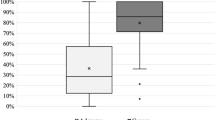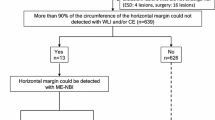Abstract
Background
Several studies have described the surface glandular structure in differentiated early gastric cancer observed by narrow-band imaging with magnifying endoscopy (NBI-ME) in two main patterns, i.e., a papillary or granular structure in an intralobular loop pattern (ILL) and a pit structure in a fine network pattern (FNP). However, it is uncertain why the NBI-ME findings of differentiated-type carcinomas are divided into two main patterns. We investigated the significance of the mucin phenotype in the morphogenetic difference between ILL and FNP.
Methods
We evaluated 120 intramucosal, well- or predominantly well-differentiated tubular adenocarcinomas. In each lesion, one area that showed the predominant pattern of microsurface structures and microvessels was selected and marked by electrocoagulation for a strict comparative study by NBI-ME and pathological investigation. NBI-ME findings were classified into three patterns: ILL, FNP, and intermediate. Mucin phenotypes were judged as gastric, intestinal, or gastrointestinal type by immunohistochemistry.
Results
The mucin phenotype was gastric or gastrointestinal type in 24 (92.3%) of 26 ILL lesions. Intestinal phenotype was observed in 22 (84.6%) of 26 FNP lesions. The gastrointestinal phenotype was observed in 50 (73.5%) of 68 intermediate pattern lesions. The mucin phenotype and NBI-ME results were significantly correlated (P < 0.001).
Conclusions
The mucin phenotype of differentiated early gastric cancer might be involved in morphogenetic differences between the papillary and pit structures visualized by NBI-ME.




Similar content being viewed by others
References
Nakayoshi T, Tajiri H, Matsuda K, Kaise M, Ikegami M, Sasaki H. Magnifying endoscopy combined with narrow band imaging system for early gastric cancer: correlation of vascular pattern with histopathology (including video). Endoscopy. 2004;36:1080–4.
Yagi K, Nakamura A, Sekine A, Umezu H. Magnifying endoscopy with narrow band imaging for early differentiated gastric adenocarcinoma. Dig Endosc. 2008;20:115–22.
Yokoyama A, Inoue H, Minami H, Wada Y, Sato Y, Satodate H, et al. Novel narrow-band imaging magnifying endoscopic classification for early gastric cancer. Dig Liver Dis. 2010;42:704–8.
Shiroshita H, Watanabe H, Ajioka Y, Watanabe G, Nishikura K, Kitano S. Re-evaluation of mucin phenotypes of gastric minute well-differentiated-type adenocarcinomas using a series of HGM MUC5AC, MUC6, M-GGMC, MUC2 and CD10 stains. Pathol Int. 2004;54:311–21.
Koseki K, Takizawa T, Koike M, Ito M, Nihei Z, Sugihara K. Distinction of differentiated type early gastric carcinoma with gastric type mucin expression. Cancer. 2000;89:724–32.
Kudo S, Hirota S, Nakajima T, Hosobe S, Kusaka H, Kobayashi T, et al. Colorectal tumours and pit pattern. J Clin Pathol. 1994;47:880–5.
Japanese Gastric Cancer Association. Japanese classification of gastric carcinoma, 2nd English edition. Gastric Cancer. 1998;1:10–24.
Dixon MF. Gastrointestinal epithelial neoplasia: Vienna revisited. Gut. 2002;51:130–1.
Yagi K, Sato T, Nakamura A, Sekine A. Extent of differentiated gastric adenocarcinomas can be diagnosed by vascular pattern and white zone using magnifying endoscopy with NBI. Stomach Intestine. 2009;44:663–74. (in Japanese with English abstract).
Yao K, Anagnostopoulos K, Ragunath K. Magnifying endoscopy for diagnosing and delineating early gastric cancer. Endoscopy. 2009;41:462–7.
Yao K, Oishi T, Matsui T, Yao T, Iwashita A. Novel magnified endoscopic findings of microvascular architecture in intramucosal gastric cancer. Gastrointest Endosc. 2002;56:279–84.
Endoh Y, Tamura G, Watanabe H, Ajioka Y, Motoyama T. The common 18-base pair deletion at codons 418–423 of the E-cadherin genes in differentiated-type adenocarcinomas and intramucosal precancerous lesions of the stomach with the features of gastric foveolar epithelium. J Pathol. 1999;189:201–6.
Kushima R, Vieth M, Borchard F, Stolte M, Mukaisho K, Hattori T. Gastric-type well-differentiated adenocarcinoma and pyloric gland adenoma of the stomach. Gastric Cancer. 2006;9:177–84.
Tsukashita S, Kushima R, Bamba M, Sugihara H, Hattori T. MUC gene expression and histogenesis of adenocarcinoma of the stomach. Int J Cancer. 2001;94:66–70.
Tajima Y, Yamazaki K, Makino R, Nishino N, Aoki S, Kato M, et al. Gastric and intestinal phenotypic marker expression in early differentiated-type tumors of the stomach: clinicopathologic significance and genetic background. Clin Cancer Res. 2006;12:6469–79.
Youn Park D, Srivastava A, Ha Kim G, Mino-Kenudson M, Deshpande V, Zukerberg LR, et al. Adenomatous and foveolar gastric dysplasia: distinct patterns of mucin expression and background intestinal metaplasia. Am J Surg Pathol. 2008;32:524–33.
Takata M, Yao T, Nishiyama KI, Nawata H, Tsuneyoshi M. Phenotypic alteration in malignant transformation of colonic villous tumours: with special reference to a comparison with tubular tumours. Histopathology. 2003;43:332–9.
Hirono H, Ajioka Y, Watanabe H, Baba Y, Tozawa E, Nishikura K, et al. Bidirectional gastric differentiation in cellular mucin phenotype (foveolar and pyloric) in serrated adenoma and hyperplastic polyp of the colorectum. Pathol Int. 2004;54:401–7.
Tatematsu M, Tsukamoto T, Inada K. Stem cells and gastric cancer: role of gastric and intestinal mixed intestinal metaplasia. Cancer Sci. 2003;94:135–41.
Egashira Y, Shimoda T, Ikegami M. Mucin histochemical analysis of minute gastric differentiated adenocarcinoma. Pathol Int. 1999;49:55–61.
Acknowledgments
This work was supported in part by a Grant from the Japanese Foundation for Research and Promotion of Endoscopy.
Author information
Authors and Affiliations
Corresponding author
Rights and permissions
About this article
Cite this article
Kobayashi, M., Takeuchi, M., Ajioka, Y. et al. Mucin phenotype and narrow-band imaging with magnifying endoscopy for differentiated-type mucosal gastric cancer. J Gastroenterol 46, 1064–1070 (2011). https://doi.org/10.1007/s00535-011-0418-6
Received:
Accepted:
Published:
Issue Date:
DOI: https://doi.org/10.1007/s00535-011-0418-6




